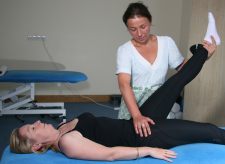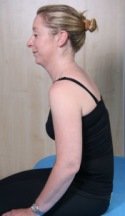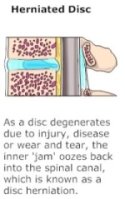Back and Neck Pain
Advice from a Chartered Physiotherapist
Many people, once they reach the age of sixty, experience back and neck pain. Too often they presume it is part of the aging process and 'live' with their aches, pains and stiffness. The truth is that reaching sixty does not mean that you have to live with your pains - there are lots of effective ways to manage your symptoms - the result being that you do not have to 'live' with pain!
Back and Neck Pain-causes and management

1. Osteo-arthritis: Although arthritis can affect us at any stage of our lives it is most commonly associated with age. Osteo-arthritis is a common symptom of aging where the surface of your bones begin to wear away resulting in stiff, creaking and often painful joint movement. So you might ask 'what can I do to get rid of my arthritis?'
Unfortunately, you cannot reverse the degeneration of the bone associated with arthritis. However, you can do a lot to prevent it from getting worse and to ease the stiffness and pain often associated with it.
When someone presents to me with arthritis I usually request x-rays of the affected joints to see the extent of the damage first. If there is inflammation in the affected joint I arrange the appropriate anti-inflammatory medication to help reduce the inflammation. I also advise the use of regular ice treatment to assist this anti-inflammatory response. Once the pain and inflammation are under control I mobilise the affected joints using physiotherapy techniques.
This immediately improves the quality and range of movement in the affected joint. Following this I prescribe the appropriate exercises to be done at regular intervals at home to help maintain the joint movement.
This sequence is usually successful but if it is not I will include dry needling in the treatment which can be the icing on the cake!
Postural correction is a necessity as is weight management, nutrition and general fitness. The important point I would like to make here is that each individual's fitness and nutritional programme will be different, so you must seek a professional's advice on your individual needs.
Do not just live with arthritic pain. Seek the help of a chartered physiotherapist. You will be delighted that you did!

2. Osteoporosis: Osteoporosis is very common as we get older especially in women. Osteoporosis is the end stage of a degenerative condition of the bones.
It is associated with calcium imbalances and can affect one bone or lots of them. Each individual is different. All my patients with osteoporosis have poor posture.
The earlier - and less aggressive stage of osteoporosis is called osteopenia. When detected early there is a lot that you can do to prevent it from progressing to osteoporosis. However, genetics play a large role with some people. So,, if you have a family history of osteoporosis ask your doctor to test you for it regularly - from the age of thirty is my advice.
When someone presents to me with osteopenia I get excited, as I know there is so much that I can do to help them! I usually advise them on the appropriate weight-bearing exercises that they need to do consistently. This in conjunction with nutritional supplements often stops this condition deteriorating into osteoporosis. I consider osteopenia silent but deadly! Left untreated it can result in long term damage to your bones.
Treatment at this stage requires physical treatment as well as medicine. Always see a chartered physiotherapist or physical therapist in conjunction with the medicine your doctor may suggest. Treatment is generally very successful in my clinic.
Unfortunately, osteoporosis is more difficult to treat. Osteoporosis is often associated with pain and movement difficulties. As physiotherapists we have to be very careful when treating people with osteoporosis as a gentle mobilisation can potentially result in a bone breaking.
I use active exercises and core strengthening programmes to treat my osteoporotic patients. The truth is that while I help them with their pain - I have little effect on the underlying condition.
In summary, always have regular bone density checks over the age of forty in order to eliminate the risk of osteoporosis. These tests are called bone density scans.
3. Degenerative disc disease: Degenerative disc disease is very common from the age of forty but unfortunately it often does not get diagnosed until the age of sixty!
Degenerative disc disease is where multiple discs in your lower back or neck get worn away. Pain and stiffness are associated with this condition.
So you might ask 'how can I get rid of my degenerative disc disease?' Unfortunately, you cannot reverse the degeneration of this condition, but the good news is that we can do lots to help relieve the pain and stiffness.
When a patient comes to me with degenerative disc disease I usually start by having their spine MRI scanned. This allows me to comprehend how severe the condition is.
From there, I mobilise the affected spine with Physiotherapy techniques. This usually eases the pain and increases the range of movement - making life easier for the patient. After this, all of my clients are advised to attend a weekly Pilate's class that has been specifically designed for this condition. Not all Pilate exercises will suit your pain so it is very important to do Pilates under the guidance of a well qualified Physiotherapist or physical therapist in this field.
Management of degenerative disc disease is hugely dependant on the compliance and diligence of the patient. Do as much as you can that your therapist tells you to do and if you do the outcome in my practice is largely excellent!

4. Spinal stenosis: Spinal stenosis is very common over the age of sixty and sometimes before! It is where one vertebra slips forwards from where it should be and compresses the spinal cord and its surrounding nerves. It can result from arthritis in the spine, bone disease, post a prolapsed disc, direct injury to the spine and from tumours.
Symptoms of spinal stenosis are progressive in onset. You may have pain in your back and legs often worse when walking or standing. Sitting usually eases it.
When patients are referred to me with spinal stenosis I insist on an MRI scan to determine the extent and severity of the condition. After that I use specific mobilisation techniques alongside postural corrections and core stability exercises. If you have spinal stenosis only do exercises under the guidance of a well qualified therapist in this area as poorly performed or incorrect exercises could result in serious consequences. Research your therapist before you go is my advice!
Although manual management is very successful in my practice surgery is also frequently required. It can be very successful once followed by appropriate Physiotherapy.
The article has been written by Sally Ann Quirke - a Chartered Physiotherpist who runs a buy practice in Fermoy in Ireland. She also runs www.managebackpain.com for her clients - where you will find many treatment approaches to mild and chronic backpain.
Back and Neck Pain are not an inevitable part of ageing. Take heart from Sally Ann Quirke’s advice-learn how to manage your symptoms-you don’t have to live with pain!
Stay in touch and subscribe to my monthly email newsletter, "Retirement Stories". It is full of new stories and tips on planning, living and enjoying an active retirement.

New! Comments
Have your say about what you just read! Leave me a comment in the box below.